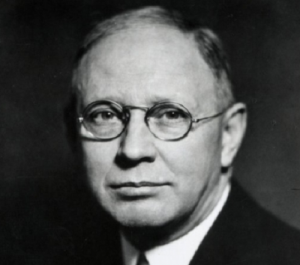Clark L. Hull and Deductive Behaviorism Theory

Clark L. Hull (1884-1952) proposed a new way of understanding behavior. Hull wanted to establish the basic principles of behavioral science to explain the behavior of different animal species as well as individual and social behavior. His theory is known as deductive behaviorism.
Hull’s theory was the most detailed and complex of the major learning theories throughout the twentieth century. For Hull, strength of habit was the most basic concept. He believed that practice reinforced habits.
Hull described habits as stimulus-response connections based on rewards. According to Hull, responses, not perceptions or expectations, are what help form habits. The process is gradual and a reward is essential.
Hull’s deductive behaviorism theory
Clark L. Hull proposed a new way of understanding behaviorism that stemmed from the logical positivism that prevailed in his time.
Like other leading theorists, Hull believed that human behavior could be explained by conditioning and reinforcement. The reduction of impulses acts as a reinforcement for behavior.
This reinforcement increases the likelihood that the same behavior will happen again when, in the future, the same need arises. Therefore, to survive in its environment, an organism must behave in a way that satisfies these survival needs. Thus, in a stimulus-response relationship, when the stimulus and the response are followed by a reduction in the need, the probability that the same stimulus “produces” the same response in the future increases.

Hull wanted to establish the basic principles of a behavioral science to explain the behavior of animals, as well as individual and social behavior. His theory of deductive behaviorism proposes habit as a central concept. The strength of the habit depends on whether the stimulus-response sequence is followed by a reinforcement. In turn, the magnitude of the reinforcement depends on the reduction of the impulse associated with a biological need.
Hull presented his learning theories for the first time in Mathematico-Deductive Theory of Rote Learning (1940), a collaboration with several colleagues, in which he expressed his findings through claims expressed in both mathematical and verbal forms.
Hull developed these ideas in Principles of Behavior (1943), where he suggested that the stimulus-response connection depends on both the type and the amount of reinforcement.
Hull’s learning theory
Hull was one of the first theorists to try to create a theory designed to explain all behavior. This learning theory, developed by Hull in 1943, is known as drive reduction theory. Hull based his theory on the concept of homeostasis, the idea that the body works actively to maintain a certain state of balance or equilibrium.
A drive, such as thirst, hunger, or cold, creates an unpleasant state or a tension. To reduce this state of tension, humans and animals seek ways to meet these biological needs (drinking, eating, finding shelter). In this sense, Hull suggested that humans and animals repeat any behavior that reduces these impulses.
Hull based his theory on the idea that people learn secondary drives (unlike primary drives, which are biological needs such as the desire for socialization, thirst, and hunger) through conditioning. These drives indirectly satisfy primary drives, such as the desire for money, as it helps to pay for shelter or sustenance.
These secondary drives occur when one faces more than one needs. The goal is to correct the disruption of equilibrium (homeostasis), which creates discomfort. A behavior is learned and conditioned if, and only if, a person satisfies a primary drive.

Hull also developed a way to express his learning theory mathematically:
sEr = V x D x K x J x sHr – sIr – Ir – sOr – sLr
In this formula:
- sEr: Excitatory potential, or the likelihood that an organism will produce a response (r) to a stimulus (s)
- sHr: Habit strength, established by the number of previous conditioning
- D: Drive strength, determined by the amount of biological deprivation
- K: Incentive motivation, or the size or magnitude of the goal
- J: The delay before the organism is allowed to seek reinforcement
- lr: Reactive inhibition, or fatigue
- slr: Conditioned inhibition, caused by previous lack of reinforcement
- sLr: Reaction threshold, the smallest amount of reinforcement that will produce learning
- sOr: Random error
According to Hull, the main takeaway of the drive reduction theory corresponds to the elimination and reduction of impulses. Since these impulses can hinder productivity, Hull’s theory implies an increase in potential productivity that can be developed in a work environment. By satisfying all needs, you can improve work performance and thus have greater success.
Conclusion
Critics believed that deductive behaviorism was too complex or that it didn’t explain human motivation as it was unable to generalize.
One of the biggest problems with Hull’s drive reduction theory is that it doesn’t take into account how secondary reinforcements reduce drives. Unlike primary drives, such as hunger and thirst, secondary reinforcements do nothing to directly reduce physiological and biological needs. Another important criticism of this theory is that it doesn’t explain why people engage in behaviors that don’t reduce drives.
In any case, this approach influenced later theories and explanations. Many of the motivational theories that emerged during the 1950s and 1960s were based on Hull’s original theory or focused on providing alternatives to drive reduction theory. A great example is Abraham Maslow’s famous hierarchy of needs, which emerged as an alternative to Hull’s approach.
Clark L. Hull (1884-1952) proposed a new way of understanding behavior. Hull wanted to establish the basic principles of behavioral science to explain the behavior of different animal species as well as individual and social behavior. His theory is known as deductive behaviorism.
Hull’s theory was the most detailed and complex of the major learning theories throughout the twentieth century. For Hull, strength of habit was the most basic concept. He believed that practice reinforced habits.
Hull described habits as stimulus-response connections based on rewards. According to Hull, responses, not perceptions or expectations, are what help form habits. The process is gradual and a reward is essential.
Hull’s deductive behaviorism theory
Clark L. Hull proposed a new way of understanding behaviorism that stemmed from the logical positivism that prevailed in his time.
Like other leading theorists, Hull believed that human behavior could be explained by conditioning and reinforcement. The reduction of impulses acts as a reinforcement for behavior.
This reinforcement increases the likelihood that the same behavior will happen again when, in the future, the same need arises. Therefore, to survive in its environment, an organism must behave in a way that satisfies these survival needs. Thus, in a stimulus-response relationship, when the stimulus and the response are followed by a reduction in the need, the probability that the same stimulus “produces” the same response in the future increases.

Hull wanted to establish the basic principles of a behavioral science to explain the behavior of animals, as well as individual and social behavior. His theory of deductive behaviorism proposes habit as a central concept. The strength of the habit depends on whether the stimulus-response sequence is followed by a reinforcement. In turn, the magnitude of the reinforcement depends on the reduction of the impulse associated with a biological need.
Hull presented his learning theories for the first time in Mathematico-Deductive Theory of Rote Learning (1940), a collaboration with several colleagues, in which he expressed his findings through claims expressed in both mathematical and verbal forms.
Hull developed these ideas in Principles of Behavior (1943), where he suggested that the stimulus-response connection depends on both the type and the amount of reinforcement.
Hull’s learning theory
Hull was one of the first theorists to try to create a theory designed to explain all behavior. This learning theory, developed by Hull in 1943, is known as drive reduction theory. Hull based his theory on the concept of homeostasis, the idea that the body works actively to maintain a certain state of balance or equilibrium.
A drive, such as thirst, hunger, or cold, creates an unpleasant state or a tension. To reduce this state of tension, humans and animals seek ways to meet these biological needs (drinking, eating, finding shelter). In this sense, Hull suggested that humans and animals repeat any behavior that reduces these impulses.
Hull based his theory on the idea that people learn secondary drives (unlike primary drives, which are biological needs such as the desire for socialization, thirst, and hunger) through conditioning. These drives indirectly satisfy primary drives, such as the desire for money, as it helps to pay for shelter or sustenance.
These secondary drives occur when one faces more than one needs. The goal is to correct the disruption of equilibrium (homeostasis), which creates discomfort. A behavior is learned and conditioned if, and only if, a person satisfies a primary drive.

Hull also developed a way to express his learning theory mathematically:
sEr = V x D x K x J x sHr – sIr – Ir – sOr – sLr
In this formula:
- sEr: Excitatory potential, or the likelihood that an organism will produce a response (r) to a stimulus (s)
- sHr: Habit strength, established by the number of previous conditioning
- D: Drive strength, determined by the amount of biological deprivation
- K: Incentive motivation, or the size or magnitude of the goal
- J: The delay before the organism is allowed to seek reinforcement
- lr: Reactive inhibition, or fatigue
- slr: Conditioned inhibition, caused by previous lack of reinforcement
- sLr: Reaction threshold, the smallest amount of reinforcement that will produce learning
- sOr: Random error
According to Hull, the main takeaway of the drive reduction theory corresponds to the elimination and reduction of impulses. Since these impulses can hinder productivity, Hull’s theory implies an increase in potential productivity that can be developed in a work environment. By satisfying all needs, you can improve work performance and thus have greater success.
Conclusion
Critics believed that deductive behaviorism was too complex or that it didn’t explain human motivation as it was unable to generalize.
One of the biggest problems with Hull’s drive reduction theory is that it doesn’t take into account how secondary reinforcements reduce drives. Unlike primary drives, such as hunger and thirst, secondary reinforcements do nothing to directly reduce physiological and biological needs. Another important criticism of this theory is that it doesn’t explain why people engage in behaviors that don’t reduce drives.
In any case, this approach influenced later theories and explanations. Many of the motivational theories that emerged during the 1950s and 1960s were based on Hull’s original theory or focused on providing alternatives to drive reduction theory. A great example is Abraham Maslow’s famous hierarchy of needs, which emerged as an alternative to Hull’s approach.
All cited sources were thoroughly reviewed by our team to ensure their quality, reliability, currency, and validity. The bibliography of this article was considered reliable and of academic or scientific accuracy.
- Hull, C. L., Hovland, C. I., Ross, R. T., Hall, M., Perkins, D. T., & Fitch, F. B. (1940). Mathematico-deductive theory of rote learning: a study in scientific methodology. Oxford, England: Yale Univ. Press.
- Hull, C. L. (1943). Principles of behavior: an introduction to behavior theory. Oxford, England: Appleton-Century.
- Leahey, T. (1998). Historia de la psicología. Madrid: Prenti Hall.
This text is provided for informational purposes only and does not replace consultation with a professional. If in doubt, consult your specialist.







